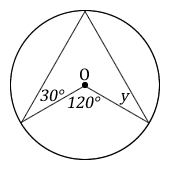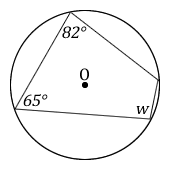Form 3 Mathematics
Chapter 8: Geometry 2
8.1. Introduction
8.2. Parts of a circle
8.3. Circle theorems
8.3.1. Angles in the semicircle are right angle
8.3.2. Angle on a straight line is 180°
8.3.3. Angles in the same segment are equal
8.3.4. The angle subtended at the center of the circle by an arc is twice the size of the angle on the circumference subtended by the same arc
8.3.5. Opposite angles of a cyclic quad add up to 180°
8.3.6. Exterior angle of a cyclic quad is equal to the interior opposite angle
8.3.7. The angle between a tangent at a point and the radius to the same point on the circle is a right angle
8.3.8. Angles in the alternate segments are equal
8.3.9. Equal chords subtend equal angles
8.3.10. Tangents from same external point to a circle are equal
8.4. Summary
8.5. Further reading
8.6. Test 8
8.1. Introduction
Circle geometry is a very simple and enjoyable topic. In this topic, we are going to discover the relationship between angles inside and outside a circle. There are rules or theorems you should know and once you have understood those theorems you will be able to apply them to solve problems in circle geometry.
Objectives
After going through this chapter, you should be able to
- use facts about parts of the circle to show relationships between angles and sides.
-
apply circle theorems to calculate lengths of lines and angles by using
- angles at the center of a circle and angles subtended at the circumference,
- angles in the same segment,
- angles in the semi-circle,
- angles in the alternate segments,
- angles in a cyclic quadrilateral.
Key terms
Arc - Is a part of the circumference or an incomplete circle.
Chord - Is a line joining two points on a circle but not passing through the center of that circle.
Diameter - Is a line joining two points on the circumference passing through the center of that circle.
Segments - Are two parts of the circle cut by a chord.
Subtend - Is an angle formed by two lines meeting at a point on the circumference from each end of a chord.
Tangent - A line, curve, or surface that touches another curve or surface but does not cross or intersect it.
Theorem - Is a proven law or fact or rule.
Time
You should not spend more than 10 hours in this chapter.
Study skills
This topic builds on the topic on Geometry 1 that was covered in chapter 7. The key to mastery of mathematics is practice. You need to work out as many problems as possible about circle geometry to have a better understanding of the subject.
8.2. Parts of a circle
In Level 1 we learnt about the parts of a circle. Do you still remember the names given to the various parts of a circle?
You may attempt the following exercise.
Exercise 8.1: Parts of a circle
Questions
-
Name the parts of a circle in the diagram.
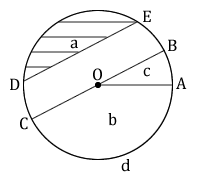
-
Name the line
- OA
- BC
- DE
Answers
- a - segment, b - sector, c - sector
-
- OA - radius
- BC - diameter
- DE - chord
8.3. Circle theorems
8.3.1. Angles in the semicircle are right angle
Figure 8.2: Angles in the semicircle
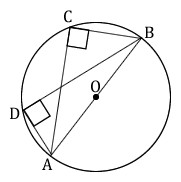
In figure 8.2 O is the center and AB is a diameter of the circle. If lines are drawn from A and B to meet at C, the angle formed (subtended) is 90° (right angle). Similarly, the two lines from A and B meet at D, again 90° is formed.
8.3.2. Angle on a straight line is 180°
Figure 8.3: Angle on a straight line

Angle at the center is twice the angle at the circumference. That is, the angle subtended at the circumference is half that subtended at the center. Have you noticed that Theorem 2 is related to Theorem 1?
8.3.3. Angles in the same segment are equal
Figure 8.3: Angles in the same segment
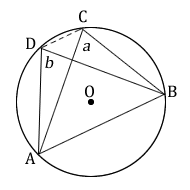
Angles in the same segment of a circle are equal. Angle ADB and angle ACB are in the same segment hence they are equal.
You may attempt the following exercise.
Exercise 8.2: Circle theorems
Questions
-
In the diagram, O is the center of the circle.

- State angles which are equal and give reasons.
- Angles BEC = 20°. Calculate angle b.
- What is the size of a?
-
In the diagram, it is given that XZY = 80°.

- State angles a and b and give reasons.
- If XO is 6cm what is the length of YO. Give reason.
- What is the size of angle OXY and OYX?
Hint: Draw line XY first before attempting c.
Answers
-
- a = d. Angles in the same segment.
- b = 20°.
- a = 90°. Angles subtended on the circumference.
-
- a = b = 80°.
- YO = 6cm. XO = YO, radius of same circle
- OXY = 160°, OYX = 160°.
8.3.4. The angle subtended at the center of the circle by an arc is twice the size of the angle on the circumference subtended by the same arc
Figure 8.7: Angle subtended at the center

Figure 8.8: Angle subtended at the center
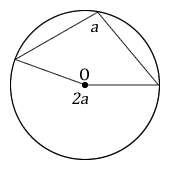
8.3.5. Opposite angles of a cyclic quad add up to 180°
Figure 8.9: Opposite angles of a cyclic quad
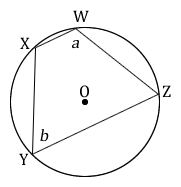
A cyclic quadrilateral is a rectangle that has all its four vertices on the circumference of a circle. Angle a + b = 180°, therefore opposite angles of a cyclic quad add up to 180° (supplementary).
8.3.6. Exterior angle of a cyclic quad is equal to the interior opposite angle
Figure 8.10: Exterior angle of a cyclic quad

Since a + b = 180° (supplementary), b + c = 180° (angles on a straight line), it follows that a = c. Therefore the exterior angle of a cyclic quad is equal to the interior opposite angle.
Example 1
Questions
-
The diagram shows a cyclic quadrilateral in a circle with center O. By applying some theorems you have learnt, calculate angle x.
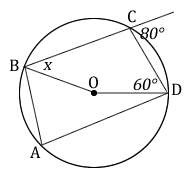
Answers
-
Step 1:
Applying angles on a straight line.
BCD = 180° - 80° = 100°.
Step 2:
BAD, exterior angle of cyclic quad is equal to the opposite interior angle.
BAD = 80°
Step 3:
BOD, angles at the center is twice the angles on the circumference.
BOD = 2 × 80° = 160°
Step 4:
x = 360° - (100° + 160° + 60°), sum of the angles in a cyclic quadrilateral.
x = 360°- 320°
x = 40°
You may attempt the following exercise.
Exercise 8.3: Circle theorems
Questions
-
Use the diagram to answer the following questions.
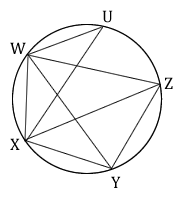
- Which arc subtends angle WUX.
- Identify an angle equal to angle WUX.
- Which arc subtends angle YXZ.
- Identify an angle equal to angle YZW.
- Which arc subtends angle XWY?
-
Calculate the marked angle in each of the following. O indicates center of the circle.
-
Answers
-
- WX.
- WZX and WYX.
- YZ.
- YUW.
- XY.
-
- x = 60°.
- y = 90°.
- x = 60°.
- w = 98°.
8.3.7. The angle between a tangent at a point and the radius to the same point on the circle is a right angle
Figure 8.17: Angle between tangent and a radius in a circle is a right angle

8.3.8. Angles in the alternate segments are equal
A chord is any straight line drawn across a circle and then it divides the circle into segments. The following diagram shows chord BC which divides the circle into two segments. Angle BCY and angle BAC are angles in alternate segments because they are in opposite segments.
Figure 8.18: Angles in the alternate segments are equal
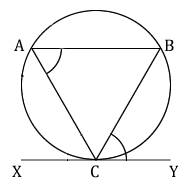
The alternate segments theorem states that an angle between a tangent and a chord through a point of contact is equal to the angle in the alternate segment. This means that angle BCY and BAC are equal.
8.3.9. Equal chords subtend equal angles
AB and AD are two equal chords. AB subtends angle ACB, this angle is equal to angle ACD which is subtended by chord AD.
Figure 8.19: Equal chords subtend equal angles
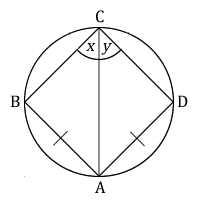
Since the chords are equal, this means that angle x and angle y are equal.
8.3.10. Tangents from same external point to a circle are equal
Figure 8.20 shows what is meant by theorem 10, AT = AB. The two tangents are starting from A to the circle at T and B.
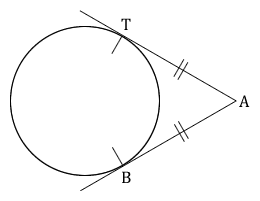
Example 2
Questions
-
The diagram shows circle with center O. ZX and ZY are tangents. Given that angle OXB = 20°, you are required to find angle XZY.

Answers
-
According to theorem 10, OX and XZ meet at 90°.
ZXB = 90° − 20° = 70°
ZX = ZY (tangents to a circle)
Therefore ZXY is an isosceles triangle.
ZXY = ZYX (base angles of isosceles triangle)
Therefore XZY = 180° − (2 × 70°)
XZY = 180° − 140°
XZY = 40°
Example 3
Questions
-
In the diagram, BDC is a circle. BC is a chord. AB and AC are tangents. Angle BAC = 50°. Calculate angle BDC.
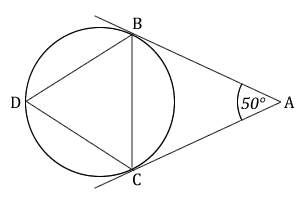
Answers
-
ABC is an isosceles triangle. (tangents are equal)
\( BCA = \dfrac{1}{2} (180° − 50°) \)
\( BCA = \dfrac{130}{2} \)
\( BCA = 50° \)
BDC = 65° (triangles in the alternate segment)
Example 4
Questions
-
In the diagram, MHJ is a tangent and LHK is a circle. Angle LHK and LKH are given. Calculate KHJ.

Answers
-
HLK = 180° - (60° + 35°) (sum of angles in a triangle)
HLK = 180° - 95°
HLK = 85°
therefore KHJ = 85° (angles in the alternate segment)
You may attempt the following exercise.
Exercise 8.4: Circle theorems
Questions
-
In the diagram, PT is a tangent, ABP = 52°, is semi-circle, O is center. Calculate
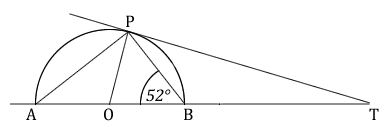
- BOP.
- BAP.
- APB.
-
The diagram shows a tangent ABC to a circle BDEF. FB and DB are chords and ABF = 40°. Name four angles which are equal to 40°. Give reasons where possible.
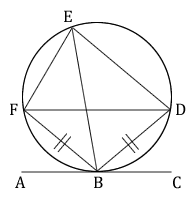
-
Using the diagram, calculate the required angle when given angles as follows.

- XCB = 55°, calculate XZB.
- XBZ = 60°, BXZ = 54°, calculate XCB.
- XBZ = 30°, ZBA = 85°, calculate BXZ.
- ZXY = 45°, ZBA = 76°, calculate XCB.
- XZB = 56°, ZBA = 82°, calculate ZXY.
Answers
-
- BOP = 76°.
- BAP = 38°.
- APB = 90°.
- Angles FEB, FDB, BED and DFB are equal to 40°, the reason being that they are subtended by equal chords.
-
- XZB = 62.5°.
- BZX = 66°.
- BXZ = 85°.
- XCB = 62°.
- ZXY = 82°.
You may attempt the following exercise.
Exercise 8.5: Circle theorems
Questions
-
The diagram shows a circle ABCY. XYZ is a tangent to a circle at Y.

- Name two angles equal to angle AYZ.
- Name two angles equal to angle CXY.
- Which angle is equal to angle BYZ?
- Which angle is equal to angle BYX?
- If angle ACY is 60°, what is angle AYZ?
- If angle BYX is 110°, what is angle BAY?
- If angle BCY is 130°, calculate angle BAY?
- If angle BYZ is 110°, what is angle BCY?
Answers
-
- ABY and ACY.
- CBY and CAY.
- BCY.
- BAY.
- 60°.
- 110°.
- 50°.
- 110°.
8.4. Summary
In this chapter you have learnt about parts of a circle and circle theorems. You should use them when answering questions on circle geometry.
8.5. Further reading
- Macrae, M. F., Madungwe, L. and Mutangadura, A. (2017). New General Mathematics Book 3. Pearson Capetown.
- Macrae, M. F., Madungwe, L. and Mutangadura, A. (2017). New General Mathematics Book 4. Pearson Capetown.
- Meyers, C., Graham, B., Dawe, L. (2004). Mathscape Working Mathematically. 9th Edition. MacMillan.
- Pimentel, R. and Wall, T. (2011). International Mathematics. Hodder UK.
- Rayner, D. (2005). Extended Mathematics. Oxford New York.
8.6. Test 8
Questions
-
The diagram shows a circle ABC with center O. Calculate angle x.

-
The diagram shows a circle ABCD. AB is the diameter and angle ACD is 35°.
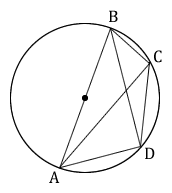
- Calculate angle ABD.
- Calculate angle BAD.
-
In the diagram, XRY is a tangent to circle PQR at R, PQ = QR and angle PQR = 70°.
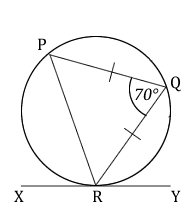
- Calculate angle PRX.
- Calculate angle QPR.
- Calculate angle QRY.
-
In the diagram, RY is the diameter, XR = RZ. Given that angle RXZ = 50°, find angle XYZ.
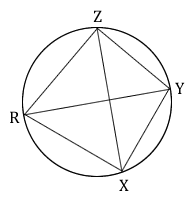
-
The diagram shows a circle with center O. CT and AT are tangents to the circle. Angle AOC = 160°.
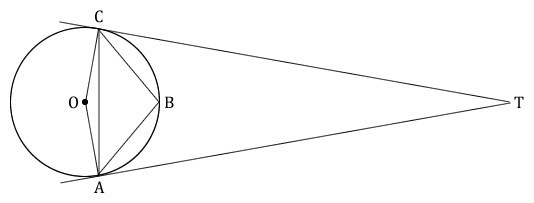
- Calculate angle CAT.
- Calculate angle ABC.
- Calculate angle CTA.
- Calculate angle OAC.
-
In the diagram, O is the center of a circle ABCD, angle ABC = 128°. Calculate the sizes of angles marked x, y, z and r.
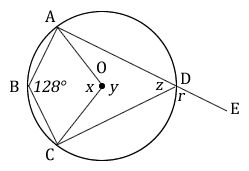
Answers
- x = 112.5°.
-
- 35°.
- 55°.
-
- 70°.
- 55°.
- 55°.
- 100°.
-
- 80°.
- 100°.
- 20°.
- 10°.
-
- x = 104°.
- y = 256°.
- z = 52°.
- r = 128°.


